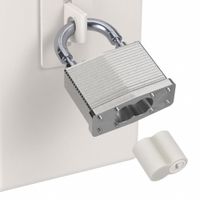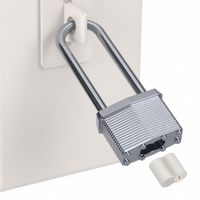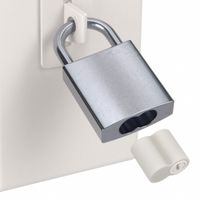Call +(254) 703 030 000 / 751 483 999 / 721 704 777
- Home
- Security
- Locks
- Keyed Padlocks Padlock Keys
- Coreless Keyed Padlocks
.....Read More
Frequently Asked Questions
What is a coreless keyed padlock?
A coreless keyed padlock is a type of padlock that does not have a removable core or cylinder, which is typically found in traditional padlocks. Instead, the locking mechanism is integrated directly into the body of the padlock. This design can offer several advantages, such as increased security and durability, as there are fewer components that can be tampered with or damaged.
In a coreless keyed padlock, the key interacts directly with the locking mechanism, which is often more compact and robust compared to those with removable cores. This can make the lock more resistant to picking and other forms of manipulation. Additionally, the absence of a removable core means there are fewer seams or joints, reducing potential points of entry for tools used in forced entry attempts.
These padlocks are often used in environments where high security is a priority, such as in industrial settings, storage facilities, or for securing valuable equipment. They are also favored in situations where the lock is exposed to harsh weather conditions, as the integrated design can offer better protection against moisture, dust, and other environmental factors.
While coreless keyed padlocks provide enhanced security, they may lack the flexibility of rekeying that removable core padlocks offer. In situations where key control is important, and locks need to be rekeyed frequently, a coreless design might not be the best choice unless the entire lock is replaced. However, for applications where long-term security and durability are more critical, coreless keyed padlocks can be an excellent option.
How does a coreless keyed padlock work?
A coreless keyed padlock operates without a traditional cylinder core, using a unique mechanism to secure and unlock. Instead of a removable core, it integrates the locking mechanism directly into the body of the padlock. Here's how it works:
1. **Locking Mechanism**: The padlock contains a series of pins or discs that align with the key's cuts. When the correct key is inserted, these pins or discs align to create a shear line, allowing the locking mechanism to turn and release the shackle.
2. **Key Design**: The key for a coreless padlock is typically flat and features a series of grooves or cuts that correspond to the internal pins or discs. The key's design ensures that only the correct key can align the internal components to unlock the padlock.
3. **Shackle Operation**: The shackle, which is the U-shaped metal bar, is held in place by the locking mechanism. When the correct key is used, the internal components align, allowing the shackle to be released. The shackle can then be lifted to open the padlock.
4. **Security Features**: Coreless padlocks often incorporate additional security features such as hardened steel shackles, anti-pick pins, and anti-drill plates to enhance resistance against tampering and forced entry.
5. **Advantages**: The absence of a removable core reduces the risk of core-related vulnerabilities, such as core pulling or drilling. This design can also make the padlock more compact and potentially more resistant to certain types of attacks.
Overall, a coreless keyed padlock provides a streamlined and secure locking solution by integrating the locking mechanism directly into the padlock body, relying on precise key and pin alignment for operation.
What are the benefits of using coreless keyed padlocks?
Coreless keyed padlocks offer several benefits:
1. **Enhanced Security**: Without a removable core, these padlocks are less susceptible to picking and unauthorized key duplication, providing a higher level of security.
2. **Durability**: Coreless designs often feature fewer moving parts, reducing wear and tear over time. This increases the lifespan of the lock, making it more reliable in harsh environments.
3. **Cost-Effective**: The absence of a core can lower manufacturing costs, making these padlocks more affordable while still maintaining robust security features.
4. **Simplicity**: With no core to manage, these padlocks are simpler to use and maintain. This can be particularly beneficial in settings where multiple users need access without the complexity of managing interchangeable cores.
5. **Weather Resistance**: Many coreless padlocks are designed to withstand extreme weather conditions, making them ideal for outdoor use. They often feature rust-resistant materials and sealed keyways to prevent water and dirt ingress.
6. **Lightweight**: The streamlined design often results in a lighter lock, which can be advantageous for portability and ease of use, especially in applications where weight is a concern.
7. **Tamper Resistance**: Coreless padlocks are often designed with features that resist tampering, such as hardened steel shackles and anti-drill plates, enhancing their security profile.
8. **Versatility**: These padlocks can be used in a variety of applications, from securing gates and storage units to protecting personal belongings, due to their robust and adaptable design.
9. **Aesthetic Appeal**: The sleek design of coreless padlocks can be more visually appealing, which can be a consideration for applications where appearance matters.
Overall, coreless keyed padlocks provide a combination of security, durability, and cost-effectiveness, making them a practical choice for many security needs.
How do you rekey a coreless keyed padlock?
Rekeying a coreless keyed padlock involves replacing the internal components that interact with the key. Here’s a step-by-step guide:
1. **Gather Tools and Materials**: You will need a new set of pins, a pinning kit, tweezers, a screwdriver, and a new key.
2. **Open the Padlock**: Use the current key to open the padlock. This is necessary to access the internal components.
3. **Remove the Shackle**: If possible, remove the shackle to make handling easier. This may require unscrewing or releasing a retaining clip.
4. **Access the Lock Cylinder**: Locate the retaining screw or clip that holds the cylinder in place. Use a screwdriver to remove it, allowing you to slide the cylinder out of the padlock body.
5. **Disassemble the Cylinder**: Carefully remove the plug from the cylinder. This may involve removing a clip or retainer. Be cautious to prevent the pins and springs from falling out.
6. **Remove Old Pins**: With the plug removed, use tweezers to extract the old pins from the pin chambers.
7. **Insert New Pins**: Refer to a pinning chart that matches your new key. Insert the new pins into the plug’s chambers according to the key’s cut depths.
8. **Reassemble the Cylinder**: Once the new pins are in place, carefully reinsert the plug into the cylinder, ensuring the pins align with the shear line.
9. **Secure the Cylinder**: Reattach any clips or screws to secure the cylinder back into the padlock body.
10. **Test the New Key**: Insert the new key and ensure it operates the lock smoothly. Make adjustments if necessary.
11. **Reattach the Shackle**: If removed, reattach the shackle and ensure the padlock functions correctly.
12. **Final Check**: Test the padlock several times to ensure reliability.
This process requires precision and patience, as incorrect pin placement can render the lock inoperable.
Where are coreless keyed padlocks commonly used?
Coreless keyed padlocks are commonly used in a variety of settings where security is important but the risk of key duplication or lock picking needs to be minimized. These padlocks are often found in:
1. **Industrial and Commercial Settings**: Used for securing gates, storage units, and equipment in factories, warehouses, and construction sites due to their durability and resistance to tampering.
2. **Transportation and Logistics**: Employed to secure cargo containers, trucks, and trailers, ensuring that goods remain safe during transit.
3. **Utilities and Infrastructure**: Utilized by utility companies to protect critical infrastructure such as electrical substations, water treatment facilities, and telecommunications equipment.
4. **Schools and Institutions**: Used for securing lockers, storage rooms, and equipment in educational institutions to prevent unauthorized access.
5. **Retail and Business**: Applied in securing backroom doors, display cases, and cash boxes in retail environments to deter theft.
6. **Residential Use**: Sometimes used for securing gates, sheds, and storage units in residential areas, offering a higher level of security than standard padlocks.
7. **Public Facilities**: Found in securing public lockers, restrooms, and maintenance areas in parks, gyms, and recreational facilities.
8. **Military and Government**: Used in securing sensitive areas and equipment, providing a robust security solution that is resistant to unauthorized access.
9. **Aviation and Maritime**: Utilized in securing aircraft hangars, docks, and shipping containers, where high security is essential.
These padlocks are favored for their robust construction and the absence of a removable core, which reduces the risk of key duplication and enhances security.
What is the difference between standard and long shackle padlocks?
Standard shackle padlocks have a shorter shackle, typically ranging from 0.75 to 1.5 inches in height. They are designed for general security applications where the locking mechanism is close to the item being secured, such as lockers, gates, or storage units. The shorter shackle reduces the amount of exposed metal, making it more difficult for bolt cutters or other tools to access and cut the shackle. This design provides a balance between security and accessibility, making it suitable for everyday use.
Long shackle padlocks, on the other hand, feature a longer shackle, often extending beyond 1.5 inches. This design is useful in situations where the locking point is recessed or where additional reach is needed to secure multiple items together. The extended shackle allows for greater flexibility in securing items that are further apart or have larger diameters. However, the increased length also means more exposed metal, which can make the padlock more vulnerable to cutting attacks. Despite this, long shackle padlocks are often used in scenarios where versatility and reach are prioritized over maximum security.
In summary, the primary difference between standard and long shackle padlocks lies in the length of the shackle, which affects their application and security level. Standard shackles offer better security due to less exposed metal, while long shackles provide greater flexibility and reach for securing items.
How do partially hidden shackle padlocks enhance security?
Partially hidden shackle padlocks enhance security primarily by reducing the exposure of the shackle, which is the most vulnerable part of a traditional padlock. By concealing most of the shackle within the lock body, these padlocks minimize the risk of attacks such as cutting, sawing, or prying, which are common methods used by intruders to compromise locks. The limited exposure makes it difficult for bolt cutters or saws to gain the necessary leverage or access to cut through the shackle.
Additionally, the design of partially hidden shackle padlocks often includes hardened steel or other robust materials, further increasing resistance to physical attacks. The lock body itself is typically more substantial and designed to withstand tampering, adding another layer of security.
These padlocks also deter picking and manipulation attempts. The keyway is often shielded or designed with complex mechanisms that resist picking tools. The reduced shackle exposure means that even if an intruder attempts to manipulate the lock, they have limited access points to exploit.
Moreover, the design of partially hidden shackle padlocks can be more challenging to bypass using common lock-picking techniques. The internal locking mechanisms are often more sophisticated, requiring specialized tools and knowledge to defeat, which acts as a deterrent to opportunistic thieves.
In summary, partially hidden shackle padlocks enhance security by minimizing shackle exposure, using robust materials, and incorporating complex locking mechanisms, making them highly resistant to cutting, prying, and picking attempts. This design effectively deters unauthorized access and provides a higher level of protection for secured items.



